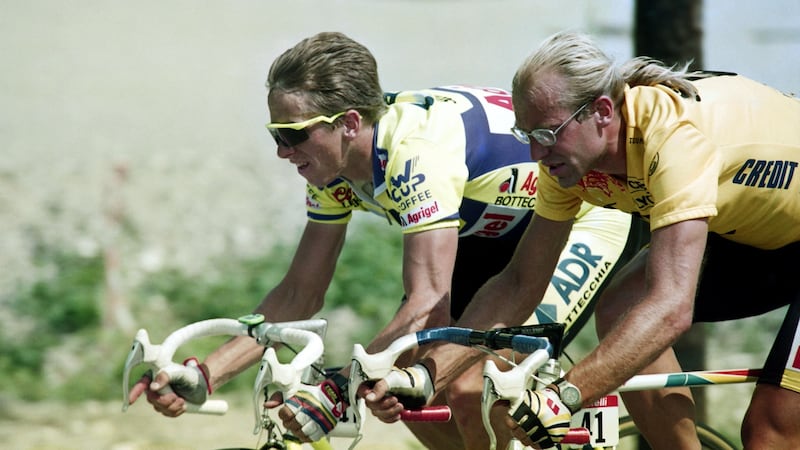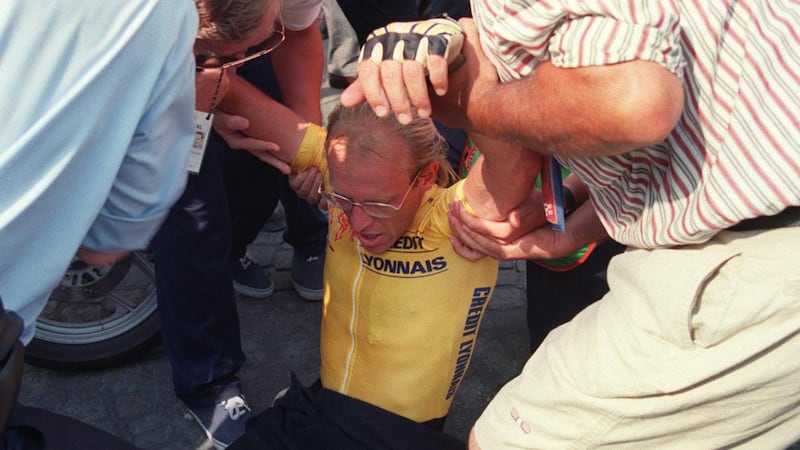Eight seconds. What can you do in eight seconds? You can’t lose a bike race of 3,285km around your own country, of 21 stages plus a prologue time-trial, by eight seconds. Can you? How on earth could it have happened?
“Come on, let’s burst the abscess before we really get started. The wound has to be left open. Let it bleed away in silence. It will bleed a good while yet.”
That's straight out of Eight Seconds, chapter one of Laurent Fignon's autobiography We Were Young and Carefree (first published in French, in 2009, as Nous étions jeunes et insouciants). That was also 20 years after Greg LeMond produced arguably the greatest upset in Tour de France history by overtaking his lead by eight seconds on the final 25.4km time-trial from the grand palace of Versailles to the Champs-Élysées, and Fignon, knowing those eight seconds would become an eternity, was still irreparably upset about.
“The morning after the defeat of the day before was when the hardest big began. I kept counting in my head: eight seconds, eight seconds. And the more I counted, the more I became aware what a derisory amount of time it was. You can’t do anything in eight seconds.”
Fignon, the same age as LeMond, died of cancer just a year later, in 2010, and what still sets their 1989 Tour duel apart is not only the fact it remains the closest in the 107-year race history – eight seconds, eight eternal seconds – but also the notion it might well have been the last miracle of cycling, before nothing could be truly counted on again, in seconds or in minutes.

It's a reminder too that as the 2020 Tour unfolds, the French are still awaiting their first winner since Bernard Hinault, in 1985. The more they reflect on the idea Fignon had that 1989 race won, the more upsetting his defeat becomes.
It was their bicentennial too – that final time-trial from Versailles to the Champs-Élysées on Sunday, July 23rd designed as a possible French cycling coronation. That Paris was Fignon’s home town added to that sense, only this was to be an American revolution in every cycling sense.
It was also Tour de France that started out with an upset, and then heaped several more upon the other. It was also my last summer living at home and the viewing of each daily stage created a lasting intrigue with professional cycling.
From the beginning then: the prologue time-trial in Luxembourg, defending champion Pedro Delgado from Spain, last to start, got his times mixed up, left two minutes and 40 seconds after his allocated slot, and ended up 2:54 behind, already the last of the 198 riders. Fignon and LeMond finished joint second, six seconds behind Erik Breukink, and just a taste of things to come.
On Stage 6, on the first individual time-trial from Dinard to Rennes, LeMond took over the yellow jersey, a further taste of things to come. They would exchange it three times before reaching Versailles: LeMond would wear it for seven days, Fignon for nine, with 50 seconds to spare going into that final 25.4km of contre la montre.
There were plenty of upsets up to and throughout the mountain stages. On Stage 8, a four-man breakaway got clear of the peloton and the first rider into Pau was Martin Earley, becoming only the fourth Irish rider in Tour history to win a stage. The next day in the Pyrenees, 1987 Tour winner Stephen Roche hit his already injured knee on his handlebars on the descent of the Col de Marie-Blanque, abandoning the day after, that stage won by a young Spanish rider named Miguel Indurain.
The second Pyrenean stage ended at the ski resort of Superbagnères, won by the Scottish rider Robert Millar, now known as Philippa York, and where Fignon took over the yellow jersey by seven seconds. He now had more than just the home support behind him.
Fignon was just 22 when he rode his first Tour in 1983 – and remains one of the rare few to win it at the first attempt, the others being Fausto Coppi, Eddy Merckx and Bernard Hinault. With that he won great admiration among the French public, who knew the considerable demands of the Tour for a youngster of 22. He won again in 1984, by then earning himself the nickname Le Professeur, in part because of his fondness for wearing round-rimmed glasses, and also because he'd spent some time at the University of Villetaneuse, studying structural and materials science, one of the few riders in the peloton with any sort of third-level experience.

The Tour has never been a popularity contest, but the French public and especially the French cycling press have always known what they like and what they like to believe in – and also being able to tell the difference.
LeMond wasn’t universally popular going back to the 1986 Tour, especially among sections of the French public and press loyal to their man Hinault, LeMond’s team-mate at La Vie Claire, who went into that race seeking a record sixth win.
LeMond versus Hinault in 1986 reached its zenith on Alpe d’Huez, after Hinault had made one last attack on the maillot jaune, worn by LeMond, only for the American to claw him right back. They reached the summit finish together, LeMond throwing his arm around Hinault like friends out on weekend ride, before allowing him to win the stage.
LeMond’s problem wasn’t just that he was American and not French: He first came to Europe in 1978, aged 17, a year later he won the World Junior road-race title, and two years after that, courted by Hinault himself and celebrated directeur sportif Cyrille Guimard, he was racing in the pro peloton with Renault-Elf-Gitane. It was also the fact he was often seen eating burgers and ice cream and playing golf on the rest days; he was unpopular for bringing his wife on the Tour and, worst of all, for speaking openly and disapprovingly about doping.
He wasn’t without his admirers, however, not least because in April 1987, two months away from defending his Tour title, he was 25 seconds away from dying. It was Easter Monday, near his home in the Sacramento Valley, when he was out turkey-shooting and was accidentally shot in the back by his brother-in-law. His life was saved by a primitive mobile phone, a police helicopter and a nearby hospital where the surgeon specialised in gunshot wounds, “part of a long chain of small miracles”. Although what ultimately saved him was his own cardiovascular strength from years of cycling.
By the time that 1989 Tour reached the Alps, Fignon and LeMond, then both 28 years old, were still locked together in battle, LeMond briefly regaining the lead, before Fignon began to gain some seemingly insurmountable time, first on Alpe d’Huez, where he moved 26 seconds ahead of the American, before winning the stage to Villard-de-Lans the next day, now sitting a comfortable 50 seconds clear, with only three stages remaining.
What only Fignon and his doctor knew was that he was also sitting on a saddle sore, after the penultimate stage from Aix-les-Bains to L’Isle-d’Abeau, and suddenly those 50 seconds weren’t looking as comfortable as they might.
It was just after 4pm on the Sunday when LeMond, making full use of his new time-trial handlebars and aerodynamic helmet, set off on the 25.4km from Versailles to the Champs-Élysées, telling his ADR directeur sportif that he didn’t want to know anything about time gaps: he was timed at 26 minutes and 57 seconds, averaging 54.4 km/h, the then fastest average time-trial speed in Tour history, and almost closing the two-minute gap on Delgado, who was now lying in third.
By every estimate, there was no way Fignon could lose more than two seconds per km, only he did, shaken more than once on the cobblestones approaching the Champs-Élysées, he long blond ponytail blowing in the wind, before crossing in 27 minutes and 55 seconds – eight seconds, eight seconds, short of LeMond’s final overall time.
In We Were Young and Carefree, he wrote: “I walk like a boxer who’s concussed, in an improbable world of furious noise. The steps I take are robotic and aren’t directed at anything. I’ve no idea where I am going and who is making me go there. I feel arms supporting me, helped me to stand up. People make noise around me. Some shout. Some look haggard, groggy, wiped out . . . ”
The American had finished in 87 hours, 37 minutes, and 35 seconds, and Fignon in 87 hours, 37 minutes and 43 seconds. LeMond won the Tour again in 1990, by over two minutes, despite not winning a stage.
What had happened to Fignon?
“I’d always felt I could be beaten. Losing was never a problem. A cyclist who doesn’t know how to lose can’t become a champion. I was used to that fact. But losing like that, on the last day, by such a minute margin and primarily because of a handlebar that had not yet been permitted by the rules; no, all that was too much for just one man. I was nearly 29, and it wasn’t time yet to have lifelong regrets. I had only rarely been in such fine physical condition, which made this defeat feel particularly unfair. How on earth could it have happened?”













